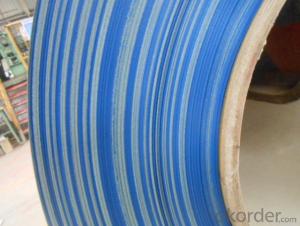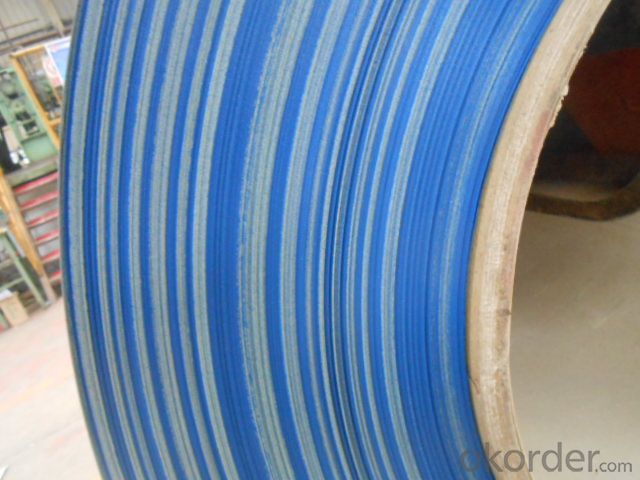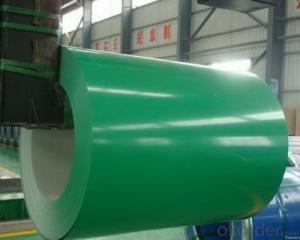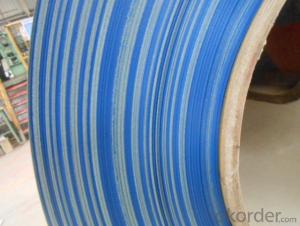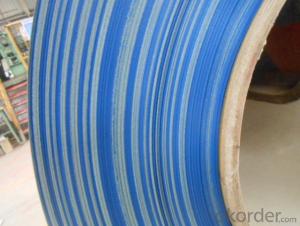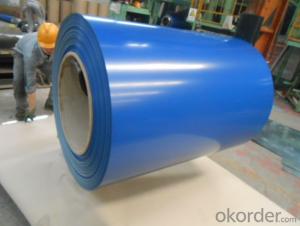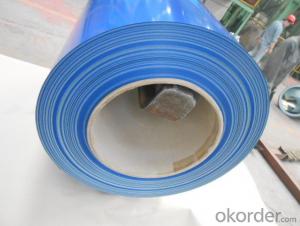PPGI,Pre-Painted Steel Coil with Prime Quality Blue Color
- Loading Port:
- Shanghai
- Payment Terms:
- TT or LC
- Min Order Qty:
- 200 m.t.
- Supply Capability:
- 20000 m.t./month
OKorder Service Pledge
OKorder Financial Service
You Might Also Like
1. Pre-Painted Galvanized/Aluzinc Steel Coil Description:
With GI as base material, after pretreatment (degrease and chemical treatment ) and liquid dope with several layers of color, then after firing and cooling, finally the plate steel is called pre-painted galvanized (aluzinc) steel. Pre-painted galvanized steel is good capable of decoration, molding, corrosion resistance. It generally displays superior workability, durability and weather resistance.
2.Main Features of the Pre-Painted Galvanized/Aluzinc Steel Coil:
• Excellent process capability
• Smooth and flat surface
• Workability, durability
• Excellent heat resistance performance
• High strength
• Good formability
• Good visual effect
3.Pre-Painted Galvanized/Aluzinc Steel Coil Images
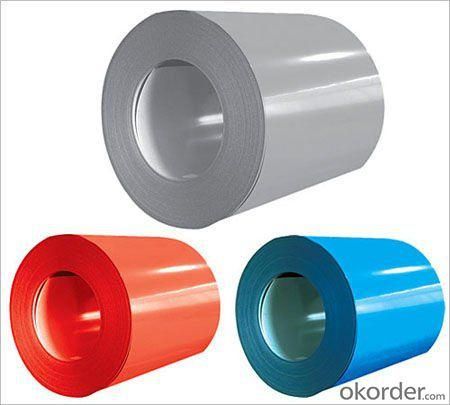
4.Pre-Painted Galvanized/Aluzinc Steel Coil Specification
Standard: AISI, ASTM, BS, DIN, GB, JIS
Grade: DX51D, DX52D
Thickness: 0.17-2.0mm
Brand Name: KMRLON
Model Number: coil
Type: Steel Coil
Technique: Cold Rolled
Surface Treatment: Coated
Application: Boiler Plate
Special Use: High-strength Steel Plate
Width: 20-1250mm
Length: customized
commoidty: pre-painted galvanized steel coil
Thickness: 0.13-4.0mm
width: 20-1250mm
zinc coating: 40-180g/m2
printing thickness: top side: 20+/-5 microns, back side: 5-7 microns
color: all RAL color
surface treatment: color coated
coil weight: 4-7 tons
coil ID: 508/610mm
packaging: standard seaworthy packing
5.FAQ of Pre-Painted Galvanized/Aluzinc Steel Coil
1. What’s the application of this product?
Roof, roof structure, surface sheet of balcony, frame of window, etc.
2. What’s the brand of the paint?
We use the best brand of all of the word—AKZO.
3. How to guarantee the quality of the products?
We have established the international advanced quality management system,every link from raw material to final product we have strict quality test;We resolutely put an end to unqualified products flowing into the market. At the same time, we will provide necessary follow-up service assurance.
4. How long can we receive the product after purchase?
Usually within thirty working days after receiving buyer’s advance payment or LC. We will arrange the factory manufacturing as soon as possible. The cargo readiness usually takes 15-25 days, but the shipment will depend on the vessel situation.
- Q: How are steel coils used in the production of aerospace parts?
- Due to their strength, durability, and versatility, steel coils find extensive use in the aerospace industry for the production of aerospace parts. Made from high-quality carbon steel, these coils are formed into a coil shape, facilitating their transportation and storage. In the aerospace sector, steel coils play a crucial role in manufacturing different components, including structural parts, engine parts, landing gear, and fasteners. Specifically, steel coils are extensively employed in the fabrication of aircraft frames and fuselage structures. These coils are often cut, shaped, and welded to create the necessary structural components, which contribute to the aircraft's strength and stability. Another significant application of steel coils in aerospace production is the manufacturing of engine parts. Complex shapes are formed from the processed steel coils to produce components like turbine blades, shafts, and casings. These components must withstand high temperatures, pressure, and stress, and steel coils possess the requisite strength and heat resistance for such demanding applications. Furthermore, steel coils find utility in the production of landing gear, which supports the aircraft during takeoff, landing, and ground operations. The processed steel coils are shaped into various parts of the landing gear system, including struts, beams, and brackets. These components undergo rigorous testing and require excellent strength, toughness, and fatigue resistance, all of which are provided by steel coils. Additionally, steel coils are commonly employed in the manufacturing of fasteners essential for aerospace applications. Bolts, screws, and rivets play a crucial role in joining different components together, ensuring structural integrity and safety. Steel coils are processed and formed into the desired shapes for these fasteners, offering the necessary strength and reliability for these critical connections. In summary, steel coils are indispensable in the production of aerospace parts due to their exceptional mechanical properties and reliability. Their versatility enables various shaping and processing techniques, allowing for the creation of complex and high-performance components. By incorporating steel coils into aerospace manufacturing, the industry can ensure the production of durable, safe, and efficient aircraft.
- Q: I noticed a friend's appliances are not magnetic, and mine are. Both are stainless steel. Are there two types of stainless steel or something? Thanks
- If the non magnetic one is has a brighter finish it may be that it is a ferritc stainless steel which depends only on high chromium content to keep it stainless,the duller one is likely to be the austenitic type which contains nickel as well as chromium and is usually non or only faintly magnetic and with a dull finish.Chromium rich stainless steels(ferritic and martensitic grades) are designed to be used for cutlery and strength application are always strongly magnetic (quite often permanent magnets).Stainless steels containing at least 18%chromium and 8+% of nickel are designed to be corrosion resistant and weldable,this type of steel(austenitic) is not ferromagnetic in the annealed state but the lower grades do become magnetic after cold work(hammering bending etc.The difference between magnetic grade or not rests in the crystal structure.In the austenitic types the structure is the same as that of gold and copper which is cubic close pack and,in steel,is a non magnetic form;but in low grades cold working can cause some breakdown of the austenite to the magnetic room temperature form of iron known as ferrite.Ferrite has the ordinary body centred body centred cubic form of iron which is magnetic.All of the stainless steels depend upon Chromium to form an anti-corrosion barrier at their surface;but this is only reliable in oxidising conditions(like the open air)They nearly all discolour and even rust if trapped in damp conditions where oxygen potential is low(as under wet plastic or underground ).
- Q: What are the challenges in coil recoiling for high-strength steel?
- Coil recoiling for high-strength steel presents several challenges that must be addressed. To begin with, high-strength steel possesses heightened hardness and strength, rendering it more difficult to coil than regular steel. The greater tensile strength of high-strength steel places additional strain on the recoiling machinery, potentially resulting in damage or machinery failure. Moreover, high-strength steel tends to exhibit reduced ductility, meaning it is less able to endure deformation without fracturing. Recoiling high-strength steel coils necessitates meticulous handling and control to prevent excessive bending or stretching that could lead to material breakage or cracking. Another obstacle arises from the shape memory effect of high-strength steel, whereby the material returns to its original shape after being deformed. Although this property can be advantageous in certain applications, it complicates the recoiling process as the steel coil resists reshaping into a new coil form. Furthermore, high-strength steel often possesses a more intricate microstructure compared to regular steel, characterized by various phases and grain boundaries. This complexity can heighten the difficulty of the recoiling process, as it can impact the material's mechanical properties and response to deformation. Finally, the surface finish of high-strength steel coils is crucial for many applications. Recoiling can introduce surface defects, such as scratches or marks, which may impair the functionality or appearance of the final product. Consequently, maintaining a high-quality surface finish during the recoiling process poses a significant challenge. In summary, the challenges associated with coil recoiling for high-strength steel encompass increased stress on recoiling equipment, reduced ductility, the shape memory effect, complex microstructure, and the need for a high-quality surface finish. Overcoming these challenges necessitates specialized equipment, precise control, and careful handling to ensure the integrity and quality of the recoiled high-strength steel coils.
- Q: Can steel coils be coated with anti-slip materials?
- Yes, steel coils can be coated with anti-slip materials. These coatings are often applied to improve safety and reduce the risk of accidents when handling or transporting the coils.
- Q: What are the different coil coatings available for steel coils?
- There are several different coil coatings available for steel coils, including polyester, silicone modified polyester (SMP), polyvinylidene difluoride (PVDF), plastisol, and epoxy. Each coating has its own unique properties and advantages, such as durability, weather resistance, and color retention, allowing for a wide range of applications in various industries.
- Q: given the buoyant economic growth of india, what you guys think about steel industry? what can be the major issues in this industry in the coming days
- Since2003, India has been the largest sponge iron producer in the world. In 2005, out of total global production of 56.05 mt of sponge iron, India produced around 11.1 mt (19.8%). In line with production target of 110 mt of steel (National Steel Policy) by FY20, many steel producers have announced their capacity expansion plans by signing MOUs with various state governments like Chattisgarh, Orissa and Jharkhand. The steel producers are expected to add around 8 mt of capacity by FY 08. CARE estimates that during 2006-09, demand for steel in the domestic market would grow at a CAGR of 8.4%. HR steel because of its widespread applicability is expected to grow at a CAGR of 17.5%. During this period, major demand drivers would be Consumer durables, Automobiles and Construction. Domestically, steel prices of flat products follow the international trend. Globally, steel prices are expected to firm up with continued growth in steel consumption. Further, the winds of consolidation have gathered pace with Arcelor-Mittal merger and latest acquisition of Corus by Tata Steel. The Indian steel industry has announced huge capacity expansions. With commissioning of these capacities demand-capacity ratio is expected to decline in FY 09 due to excess capacity. Will this lead to a drop in prices with commissioning of these capacities? With China and India becoming the focus of major global steel companies, will the consolidation of steel industry in these countries continue? For comprehensive analysis and CARE’s future outlook on the sector, please refer to the exhaustive report on the Indian Steel Industry by CARE Research.
- Q: How many millimeters is a number 3 steel crochet hook?
- This depends whether you have a US or a UK pattern. The pre metric UK size 3 was different to the US size 3. Google in compare US/UK crochet hooks and it gives a chart showing the metric/US/UK sizes.
- Q: What are the factors that determine the price of steel coils?
- There are several factors that determine the price of steel coils. 1. Raw material costs: The cost of raw materials, such as iron ore and coal, which are used in the production of steel, directly affect the price of steel coils. Any fluctuations in the prices of these raw materials can impact the final price of steel coils. 2. Energy costs: The energy required to produce steel coils, including electricity and fuel, is a significant factor in determining their price. Fluctuations in energy costs, such as changes in oil prices or electricity tariffs, can influence the overall price of steel coils. 3. Demand and supply: The demand and supply dynamics in the steel industry play a crucial role in determining the price of steel coils. When demand is high and supply is limited, prices tend to increase. Conversely, when demand is low and supply exceeds demand, prices tend to decrease. 4. Market conditions: The overall economic conditions and market trends can impact the price of steel coils. Factors such as economic growth, industrial production, and construction activities can influence the demand for steel and, consequently, its price. 5. Production and labor costs: The costs associated with steel coil production, including labor, equipment, maintenance, and transportation, contribute to the final price. Factors like labor wages, technological advancements, and production efficiency can influence these costs and, subsequently, the price of steel coils. 6. Trade policies and tariffs: Trade policies, including import and export tariffs, can affect the price of steel coils. Imposition of higher import tariffs can lead to an increase in domestic steel prices, while lower tariffs may result in lower prices due to increased competition from imports. 7. Currency exchange rates: Steel is a globally traded commodity, and fluctuations in currency exchange rates can impact its price. If the currency in which steel is priced strengthens against other currencies, it can result in higher prices for steel coils. It is important to note that these factors are interrelated and can vary depending on the specific market conditions, geographical location, and other external factors.
- Q: What are the different types of steel coil slitting machines?
- There are several different types of steel coil slitting machines, including rotary shear slitting machines, loop slitting machines, and tension slitting machines. Each type has its own unique features and advantages, but they all serve the purpose of cutting steel coils into narrower strips.
- Q: Hey everyone.I have a whetstone and a honing steel. I purposely tried to make one of my knives less sharp twice to see how well the whetstone and honing steel would work.It even seemed that when I was using my whetstone it wasn't as sharp as it was when I used my honing steel, but when I also used my honing steel after having sharpened my knife on the whetstone, it was razor sharp.I was wondering, is the whetstone only supposed to be used when the knife edge isn't as flat anymore or something? Like, only when it doesn't really have an edge anymore?Please explain your answer.Thanks everyone.
- You're not supposed to use the whetstone alone. It leaves a burr, which the steel removes. If you google using a whetstone, you'll see plenty of info. It is possible to use a finer stone in place of the steel.
Send your message to us
PPGI,Pre-Painted Steel Coil with Prime Quality Blue Color
- Loading Port:
- Shanghai
- Payment Terms:
- TT or LC
- Min Order Qty:
- 200 m.t.
- Supply Capability:
- 20000 m.t./month
OKorder Service Pledge
OKorder Financial Service
Similar products
Hot products
Hot Searches
Related keywords
